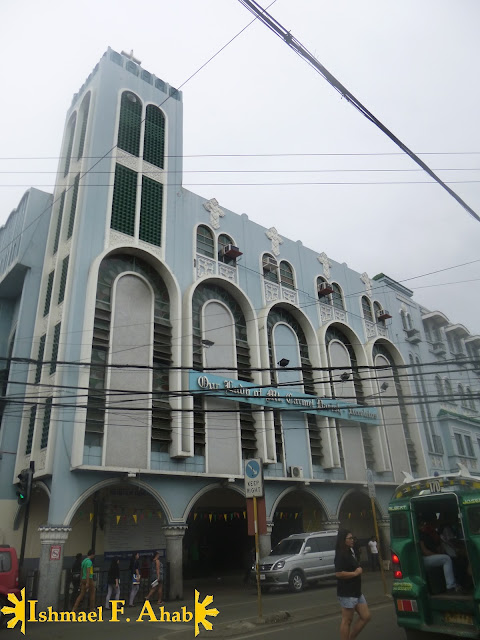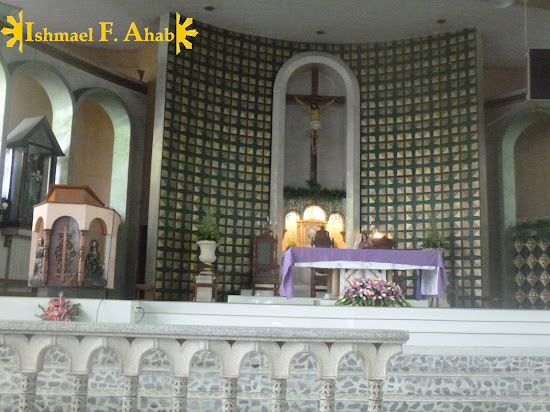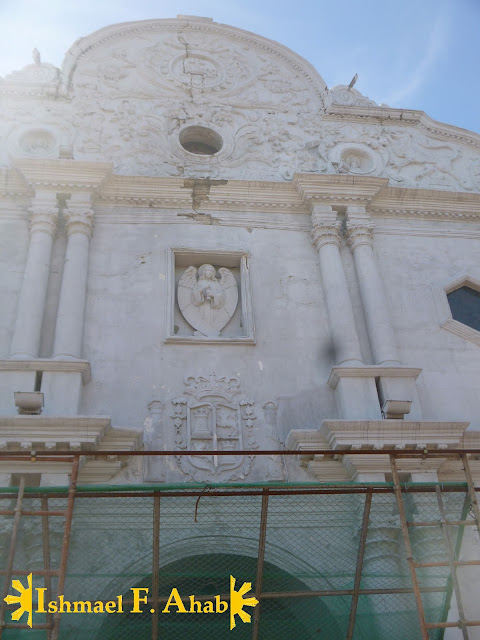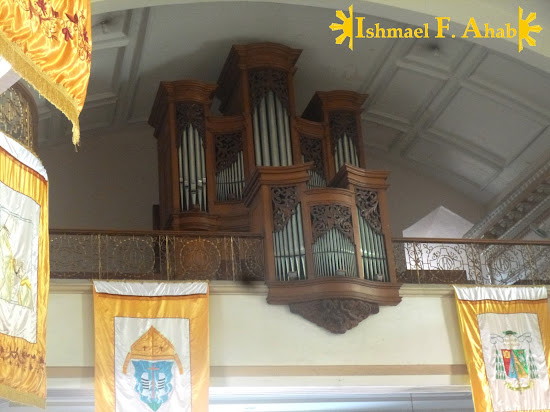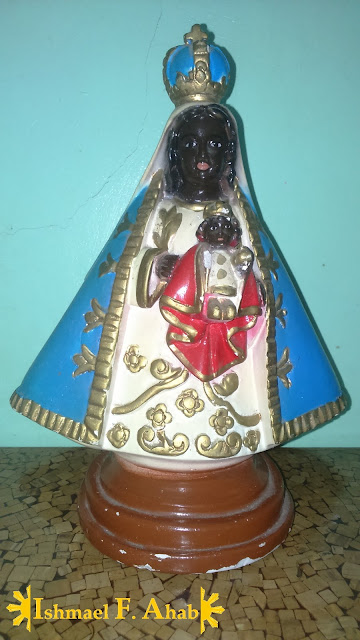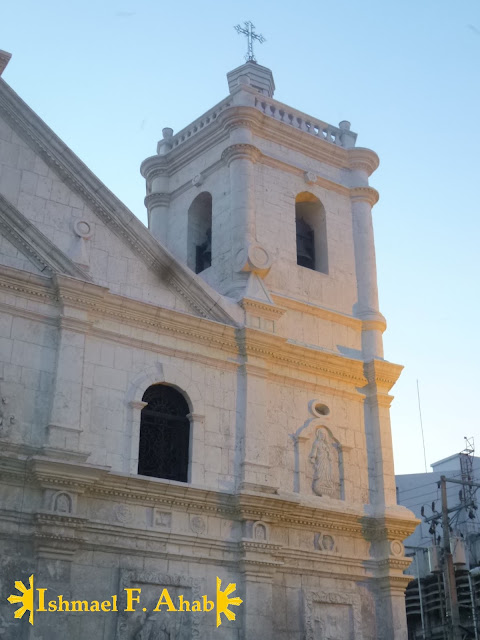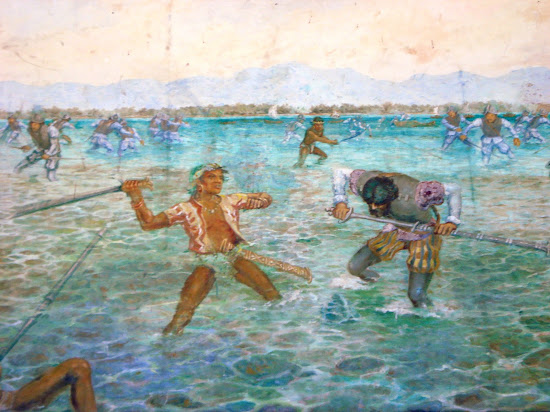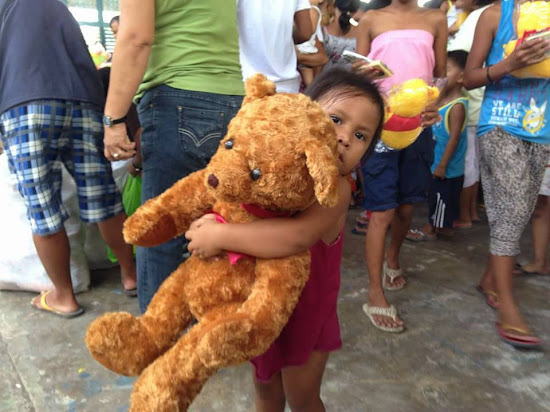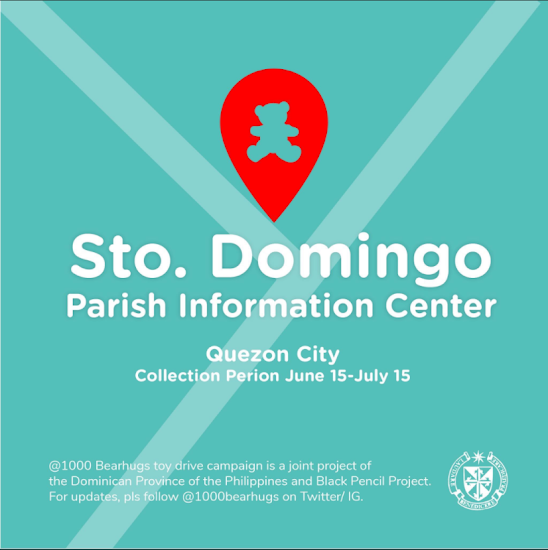In the midst of cacophony of sounds of the Carbon Market stands the modern-looking church dedicated to the Virgin Mary in her title that is less popular to Cebuanos as the Birhen sa Regla. That church is the Our Lady of Mt. Carmel Parish Church, which is under the care of the Augustinian Recollects.
I accidentally discovered this church while I was looking for a market where I can buy danggit. I know that dried seafood may be found in Tabo-an but I still tried my luck in Carbon Market.
Carbon Market is very much like the Divisoria of Cebu City. This place have stores of meat, fish, vegetables, and other non-food products. The place is crowded and confusing that I was not able to find the danggit. Well, I guess I really have to go to Tabo-an for My Beloved Wife's much requested dried fish.
Carbon Market is very much like the Divisoria of Cebu City. This place have stores of meat, fish, vegetables, and other non-food products. The place is crowded and confusing that I was not able to find the danggit. Well, I guess I really have to go to Tabo-an for My Beloved Wife's much requested dried fish.
Carbon Market and The Our Lady of Mt. Carmel Church are both located in Barangay Ermita. The barrio got its name not because it copied the name of Manila's Ermita district but because of the Augustinian Recollects that inhabited the area.
The Augustinian Recollect is a contemplative religious order. This means that their focus is more on prayers and being away from the outside world. Their way of life is very much the same as the Pink Sisters in Tagaytay City.
The Augustinian Recollects first set foot in Cebu in 1606 but they only built their hermitage on the same spot as the Our Lady of Mt. Carmel Church in 1621. Thus, Barangay Ermita got its name from the hermitage of the Augustinian Recollects.
 |
| The old Colegio de San Jose and part of hermitage of the Recollects. |
The silence inside the church is a great break from the noise of the busy Carbon Market.
Our Lady of Mt. Carmel Church is eerily silent during my visit. There is no tourist snapping photos here and there. No onlookers and noisy visitors. Just a good place to sit down and pray. I guess that the should-have-been-contemplative Recollects are successful in making this church a place for contemplation.
The Recollects should have little contact with the outside world but Filipinos attended masses at the door of their hermitage thus they have no choice but to open their place to the public. The result of this is that they became missionaries and built various learning institutions, the famous of which is the Colegio de San Sebastian - Recoletos de Manila.
Just like their old hermitage in Manila, the Recollects' hermitage in Cebu became a educational institution, which is now called the University of San Jose – Recoletos. This university was established by the Recollects in 1947.
I left Our Lady of Mt. Carmel Church after a short prayer and few photos. I went out again to the busy world of Carbon Market and the search for the dried danggit.
Just like their old hermitage in Manila, the Recollects' hermitage in Cebu became a educational institution, which is now called the University of San Jose – Recoletos. This university was established by the Recollects in 1947.
---
Read more of my latest adventure in the island of Cebu!
Laag-Laag sa Cebu (Part 19): Temple of Leah - The House of Vanity
Laag-Laag sa Cebu (Part 18): A Better Stay in Bayfront Hotel in Cebu
Laag-Laag sa Cebu (Part 17): A Great View of Cebu City from Tops Busay
Laag-Laag sa Cebu (Part 16): A Taste of Mandarin in Cebu City
Laag-Laag sa Cebu (Part 15): Taboan the Pasalubong Center of Cebu City
Laag-Laag sa Cebu (Part 13): Another Visit to the Cebu Metropolitan Cathedral
Laag-Laag sa Cebu (Part 12): Why Cebuanos Call Mama Mary as Birhen sa Regla?
Laag-Laag sa Cebu (Part 11): Sto. Niño Basilica - Mother and Head of All Churches of the Philippine Islands
Laag-Laag sa Cebu (Part 10): A Visit to the Fake(?) Magellan’s Cross
Laag-Laag sa Cebu (Part 9): The Story of Rajah Humabon - King of Cebu
Laag-Laag sa Cebu (Part 8): Calle Colon, the Oldest Street in the Philippines
Laag-Laag sa Cebu (Part 7): The Worst Cebu Hotel
Laag-Laag sa Cebu (Part 6): The Colorful Lighthouse of Lilo-an
Laag-Laag sa Cebu (Part 5): The Mysterious Church of Lilo-an
Laag-Laag sa Cebu (Part 4): Bagacay Point Lighthouse
Laag-Laag sa Cebu (Part 18): A Better Stay in Bayfront Hotel in Cebu
Laag-Laag sa Cebu (Part 17): A Great View of Cebu City from Tops Busay
Laag-Laag sa Cebu (Part 16): A Taste of Mandarin in Cebu City
Laag-Laag sa Cebu (Part 15): Taboan the Pasalubong Center of Cebu City
Laag-Laag sa Cebu (Part 13): Another Visit to the Cebu Metropolitan Cathedral
Laag-Laag sa Cebu (Part 12): Why Cebuanos Call Mama Mary as Birhen sa Regla?
Laag-Laag sa Cebu (Part 11): Sto. Niño Basilica - Mother and Head of All Churches of the Philippine Islands
Laag-Laag sa Cebu (Part 10): A Visit to the Fake(?) Magellan’s Cross
Laag-Laag sa Cebu (Part 9): The Story of Rajah Humabon - King of Cebu
Laag-Laag sa Cebu (Part 8): Calle Colon, the Oldest Street in the Philippines
Laag-Laag sa Cebu (Part 7): The Worst Cebu Hotel
Laag-Laag sa Cebu (Part 6): The Colorful Lighthouse of Lilo-an
Laag-Laag sa Cebu (Part 5): The Mysterious Church of Lilo-an
Laag-Laag sa Cebu (Part 4): Bagacay Point Lighthouse
Laag-Laag sa Cebu (Part 3): Feasting on Consolacion’s Fresh Talaba
Laag-Laag sa Cebu (Part 2): Finding Consolation in Consolacion Church
Laag-Laag sa Cebu (Part 2): Finding Consolation in Consolacion Church
A Foretaste of Cebu in Mactan Cebu International Airport
---
The image of the old hermitage of Augustinian Recollects in Cebu was obtained from the website of University of San Jose - Recoletos.
Some historical information about the Recollects in the Philippines was obtained from Simbahan.Net.
.
---
The image of the old hermitage of Augustinian Recollects in Cebu was obtained from the website of University of San Jose - Recoletos.
Some historical information about the Recollects in the Philippines was obtained from Simbahan.Net.
.



